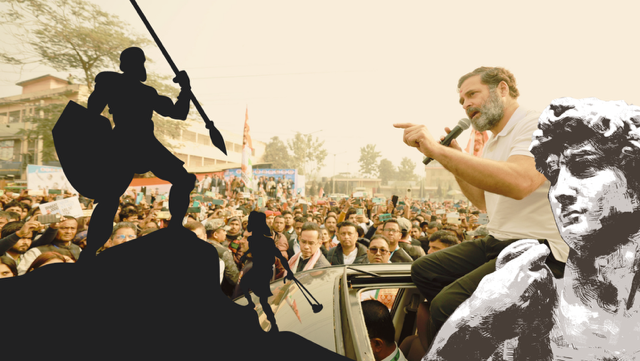Stand-up comedian Kunal Kamra noted in one of his more recent shows, “Everyone has absolute clarity about what Rahul Gandhi needs to do and knows even better than Rahul Gandhi what Rahul Gandhi should do.”
As if to prove the truth in his wry observation, media commentators, analysts and columnists on both sides of the political divide seem to be convinced that the Congress leader is wasting his time doing a second Bharat Jodo Yatra this close to the Lok Sabha elections of 2024.
Conventional wisdom, they say, dictates that the Congress should not be wasting its time and limited resources on another “feel good” yatra, but should instead be focusing on other more pressing matters.
But the question begs to be asked: What good is conventional wisdom when all the conventions and institutions that make for a healthy democracy have been effectively hijacked by the government in power?
Everyone knows the next general elections will be an unequal fight. On one side is the ruling party with big money, big media, and all the investigating agencies at its beck and call; on the other, a beleaguered and fragile opposition alliance under relentless siege by the state. What we are looking at is very much a David vs Goliath faceoff, the ultimate metaphor for unequal battles.
It might, in fact, be useful to explore the actual battle between David and Goliath in some depth. In his book, David and Goliath: Underdogs, Misfits and the Art of Battling Giants, bestselling author Malcolm Gladwell has elaborated at some length on the historical underpinnings of this event which is said to have taken place in the heart of ancient Palestine in the latter half of 11th century BC.
The fledgling kingdom of Israel under its first king, Saul, was under siege by the Philistines, a battle-hardened, sea-faring warrior race from Crete. The Philistines had set up camp along the southern ridge of the Elah valley and the Israelites, a mountain-dwelling people, had pitched their tents along the northern ridge on the other side. Between them lay a ravine. Neither side moved, for, to attack would have meant descending into the ravine and making a suicidal climb up the enemy’s ridge up the other side.
Tiring of the stalemate, the Philistines finally sent their most terrifying warrior, Goliath of Gath, down into the valley to resolve the deadlock in one-on-one, hand-to-hand combat. For 40 days every morning and every evening, Goliath shouted his taunts at King Saul and the army of Israel.
The Book of Samuel, in which this story is recorded, notes that Goliath was about eight feet tall, covered with armour from head to toe and carried a bronze javelin capable of wreaking serious damage. One can understand why the Israelites were having a difficult time finding a volunteer to go up against him.
That is, till David, a young shepherd with no military experience came along and offered to go and fight the giant. King Saul tried to dissuade the young man, but finally unable to do so, offered David his own armour. David tried it on but said, “I cannot walk in these for I am unused to it.”
When Goliath saw David approaching, he roared, “Am I a dog that you should come to me with sticks?” What happened next, of course, is history. David picked up five smooth stones from the riverbed, loaded one into his slingshot, ran towards Goliath and let fly. The stone found its mark – right in the centre of Goliath’s forehead – and the giant crumpled.
In his book, Gladwell mentions Eitan Hirsch, a ballistics expert who did a series of calculations showing that a typical-size stone hurled by an expert slinger at a distance of 35 metres would have hit Goliath’s head with a velocity of 34 metres per second – more than enough to penetrate his skull and render him unconscious or dead.
What is even more interesting is what many medical experts now believe. Gladwell explains:
“Goliath, it seems, had a serious medical condition called acromegaly—a disease caused by a benign tumor of the pituitary gland. The tumor causes an overproduction of human growth hormone, which would explain Goliath’s extraordinary size. (The tallest person in history, Robert Wadlow, suffered from acromegaly. At his death, he was eight foot eleven inches, and apparently still growing.)
One of the common side effects of acromegaly is vision problems. Pituitary tumors can grow to the point where they compress the nerves leading to the eyes, with the result that people with acromegaly often suffer from severely restricted sight and diplopia, or double vision. Why was Goliath led onto the valley floor by an attendant? Because the attendant was his visual guide. Why does he move so slowly? Because the world around him is a blur. Why does it take him so long to understand that David has changed the rules? Because he doesn’t see David until David is up close.”
But David won because he changed the rules of engagement. And Goliath lost because he quite literally did not see David coming or anticipate his speed and agility.
At a time when godi media channels have already declared Narendra Modi the winner of 2024 – especially after the grand and carefully choreographed pran pratishtha ceremony at the much awaited (and currently unfinished) Ram temple in Ayodhya – perhaps the need of the hour is not a conventional approach.
Perhaps Rahul Gandhi is doing exactly what a leader of an opposition party needs to do at this critical juncture in India’s history: bypassing the restrictions of state-controlled media, personally connecting with hundreds of thousands on the ground, and raising five key issues of social justice – justice for the youth, equal representation, justice for women, justice for farmers and justice for labourers.
Incidentally, according to a recent survey by Statista Consumer Insights, these are fundamentally the same issues that 24,000 online respondents consider to be the most pressing: unemployment, education, poverty and the environment.
The most challenging phases of the Bharat Jodo Nyay Yatra are yet to come as it passes through Bharatiya Janata Party-ruled states, but judging by both the enthusiastic response the yatra has received from the people of the northeast, and the subsequent pushback from the BJP government in Assam (always a sign that an initiative is working), Rahul Gandhi and the Congress may find they have much more than just a hope in hell.
Rohit Kumar is an educator, author, and independent journalist, and can be reached at [email protected].

